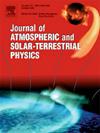Dst index estimation from cosmic ray and solar wind data during solar cycle 24 using artificial neural networks
IF 1.9
4区 地球科学
Q3 GEOCHEMISTRY & GEOPHYSICS
Journal of Atmospheric and Solar-Terrestrial Physics
Pub Date : 2025-02-12
DOI:10.1016/j.jastp.2025.106462
引用次数: 0
Abstract
This research employs artificial neural networks (ANNs) to estimate the disturbance storm time (Dst) index using cosmic ray (CR) and solar wind (SW) data from solar cycle 24. A dataset of 1361 events (2008–2019) was compiled and divided into training and testing subsets. Validation was performed using a dataset of 116 events from the year 2005. The flexibility and robustness of the model was further verified with three geomagnetic storms (GSs) representing different conditions during solar cycle 23. The CR parameters, SW parameters, and geomagnetic indices were sourced from the Forbush Effects and Interplanetary Disturbance (FEID) Catalogue and NASA's OMNI database. The ANN model utilized a feedforward neural network with Levenberg-Marquardt backpropagation, achieving optimal performance with a single hidden layer of six neurons, which minimized the root mean square error (RMSE). The model's overall correlation coefficient was 87%, indicating strong predictive capability. The results demonstrate the ANN model's efficacy in capturing complex interactions between solar and cosmic-ray phenomena and their impacts on geomagnetic activity, providing a robust tool for space weather studies. Additionally, the strong correlation observed between the Dst index and cosmic ray data suggests that incorporating these data in future studies could be highly valuable.
利用人工神经网络估算第24太阳周期宇宙射线和太阳风数据的Dst指数
本研究利用第24太阳周期的宇宙射线(CR)和太阳风(SW)数据,采用人工神经网络(ann)估算扰动风暴时间(Dst)指数。编译了1361个事件(2008-2019)的数据集,并将其分为训练和测试子集。使用2005年以来的116个事件的数据集进行验证。在太阳活动周期23的3次地磁风暴中,进一步验证了模型的灵活性和鲁棒性。CR参数、SW参数和地磁指数来源于Forbush效应和行星际扰动(FEID)目录和NASA的OMNI数据库。该模型利用Levenberg-Marquardt反向传播的前馈神经网络,通过单个6个神经元的隐藏层实现了最优性能,使均方根误差(RMSE)最小化。模型总体相关系数为87%,预测能力较强。结果表明,人工神经网络模型在捕捉太阳和宇宙射线现象之间复杂的相互作用及其对地磁活动的影响方面是有效的,为空间天气研究提供了一个强大的工具。此外,在Dst指数和宇宙射线数据之间观察到的强相关性表明,将这些数据纳入未来的研究可能是非常有价值的。
本文章由计算机程序翻译,如有差异,请以英文原文为准。
求助全文
约1分钟内获得全文
求助全文
来源期刊

Journal of Atmospheric and Solar-Terrestrial Physics
地学-地球化学与地球物理
CiteScore
4.10
自引率
5.30%
发文量
95
审稿时长
6 months
期刊介绍:
The Journal of Atmospheric and Solar-Terrestrial Physics (JASTP) is an international journal concerned with the inter-disciplinary science of the Earth''s atmospheric and space environment, especially the highly varied and highly variable physical phenomena that occur in this natural laboratory and the processes that couple them.
The journal covers the physical processes operating in the troposphere, stratosphere, mesosphere, thermosphere, ionosphere, magnetosphere, the Sun, interplanetary medium, and heliosphere. Phenomena occurring in other "spheres", solar influences on climate, and supporting laboratory measurements are also considered. The journal deals especially with the coupling between the different regions.
Solar flares, coronal mass ejections, and other energetic events on the Sun create interesting and important perturbations in the near-Earth space environment. The physics of such "space weather" is central to the Journal of Atmospheric and Solar-Terrestrial Physics and the journal welcomes papers that lead in the direction of a predictive understanding of the coupled system. Regarding the upper atmosphere, the subjects of aeronomy, geomagnetism and geoelectricity, auroral phenomena, radio wave propagation, and plasma instabilities, are examples within the broad field of solar-terrestrial physics which emphasise the energy exchange between the solar wind, the magnetospheric and ionospheric plasmas, and the neutral gas. In the lower atmosphere, topics covered range from mesoscale to global scale dynamics, to atmospheric electricity, lightning and its effects, and to anthropogenic changes.
 求助内容:
求助内容: 应助结果提醒方式:
应助结果提醒方式:


